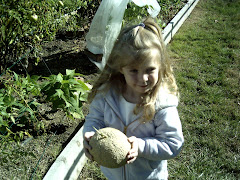
I needed a way to keep the side pieces of the hoop house from blowing around in the wind and I have to admit, my husband had a great idea. He took 2 more pieces of the 1/2" pvc pipe and used duct tape to secure the plastic to the pipe. Now I can roll it up and use some clamps to hold it in place when open. When closed, I use the clamps to secure the side pieces to the raised bed because they are so light weight. I keep the ends closed with old bricks.

I transplanted some of the lettuce I have been growing indoors for salads. I have been hardening them off for the past week in anticipation of placing them out in the hoop house. I have another flat I plan on planting out sometime next week. I just wanted to make sure these took off first. We are expecting a couple nights of below freezing weather this weekend which will be a good way to determine if the plants can tolerate living out in the hoop house.
Ok, now let me tell you the way I was going to make the hoop house in case anyone wants an easier option. (See previous post for materials list.)
First I would have taken the 3/4" pvc pipe and cut it down to 8' since I wanted to be able to move it to different raised beds...I plan on making 4 4'x8' beds as my next project...but this one will have to stay put since the measurements are off because my husband decided it was too much work to cut to 8 ft...lets just leave it at that :)
So again, take the 3/4" pipe and cut to 8 ft (if desired). Make a mark 2" from the ends. Then make a mark at 2', 4', and 6' from one end. (In order to use the type of clamps I used on the raised bed, I had to come in 2" from the end to properly secure to the wood of the raised bed.)
Take 5 of the 10 ft sections of 1/2" pvc pipe (ribs) and make a mark in the center, approximately at 5'. Using the 1/4" bit and drill, drill a hole at the marks on the 1/2" pipe.
Drill a hole through one end of the 3/4" pvc pipe (spine) at the 2" mark.
Now take a bolt and washer and place through the center hole of the 1/2" pipe then through the hole in the end of the 3/4" pvc pipe. Place another washer and then the nut and tighten down. Lay flat on the ground. This will allow you to drill the rest of the holes without the pipe rolling around so everything will line up properly.
Now drill through the remaining marks on the 3/4" pvc pipe and secure the ribs to the spine as above.
At this point, it would be good to have a helper. Carry the soon to be hoop house to your raised bed and stand it up on the 5 rib pieces. Place a clamp over each of the ribs and tighten into place.
Now go to the other side of the raised bed and loosely screw your clamps into place...at the 2" mark, 2', 4', 6' and 2" in from the ends. Now bend the ribs and place into the clamps and screw down tight.
Place the plastic over top of the hoops making sure you have enough to be able to secure down the ends. Now take the remaining 2 pieces of the 1/2" pvc pipe and cut to 8 ft lengths. Place the pipe on the plastic at the sides of the hoop house and tape down well with the duct tape. You will now be able to roll up the sides as in the picture above and secure them with clamps when you want to keep it open to plant and on hot days.
Hope this all makes sense but if it doesn't, feel free to let me know and I will try to clear things up. Kim

2 comments:
Thank you for shareing
Nice set up you have- not sure it would work, but I'd make what Eliot Colman calls chenilles (caterpillar in French). I use these on my smaller beds. He cuts the plastic so it sits right at the soil or wood on the raised bed level. The wires he uses for the tunnels (where you're using pvc he uses 9 gauge wire) he puts a small loop in the wire- these hoops are used to string thin wire in a zigzag across the plastic- the plastic is then sandwiched between the 9 gauge wire and thin wire allowing you to raise or lower the plastic to vent, weed, or harvest, etc. I'm sure by now you've come up with a great solution that works for you-
Post a Comment